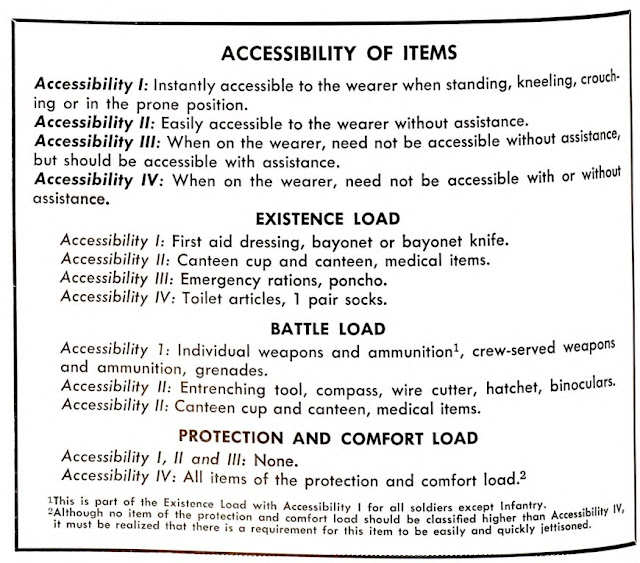My friend Ralph Zumbro had often referenced “the Pentomic division”, so recently I read “The Pentomic Era” by A. C. Bacevich. This provides an interesting insight into the politics and mindset that was behind this phase of Army history. What the book does not provide is much detail on the actual organization of the Pentomic divisions. Thus, a few nights ago I could be found wading through an on-line copy of “Infantry”, 1957-1958.
One thing I came across was an article (p.34, April-June 1958) on the new “universal, individual load-carrying system.”. Although the designation is not used, this is the M-1956 system that served in Vietnam and was replaced by what was essentially a nylon version. What caught my eye was the author divided the soldier’s load into three groupings: Battle load, existence load and protection and comfort load. “Combat load” was the battle and existence loads, “Full field load” was all three. Before entering “close combat” the soldier could jettison the existence load “except bayonet or fighting knife, first-aid pouch and other essential items”.
What were these loads?
The battle load was defined as the individual’s weapon and ammunition and weighed 25lb. This was still the era of the M1 Garand, although the M14 was just coming into service.
The existence load included emergency rations, medical items, canteen and canteen cup, toilet articles, one pair of socks, poncho and bayonet or fighting knife, and weighed 20lbs.
The comfort load included a sleeping bag, extra clothing and “personal gear” and weighed 10lbs.
The existence load was carried in the combat pack. Presumably the protection and comfort items could be stored in the sleeping bag carrier. An illustration in the article declares that clothing and other personal items can be carried inside the sleeping bag roll. Oddly, it shows a shaving kit, which you would think was a toiletry. Thus either load could be removed by just releasing a few clips. Full field load was therefore 55lbs. Compare this to the 1877 load in a previous article.
The idea of dividing and packaging the gear as several categories is interesting, although some of the details can be challenged. Why is the bayonet/ knife and first-aid pouch not part of the battle load? These would probably be carried on the webbing anyway, so would not be jettisoned with the combat pack/ existence load. One of the canteens on the webbing and part of the battle load makes sense, but the canteen cup is less vital and should be a pack item.
Essentially this approach has the soldier carrying two packs, the contents of each having different functions and different priorities. You can create a similar system by having a large pack and one or more smaller packs that clips onto or fits in the larger. It is a set of ideas to play around with.
If you have enjoyed this article or it has been helpful to you please feel free to show your appreciation. Thank you.






